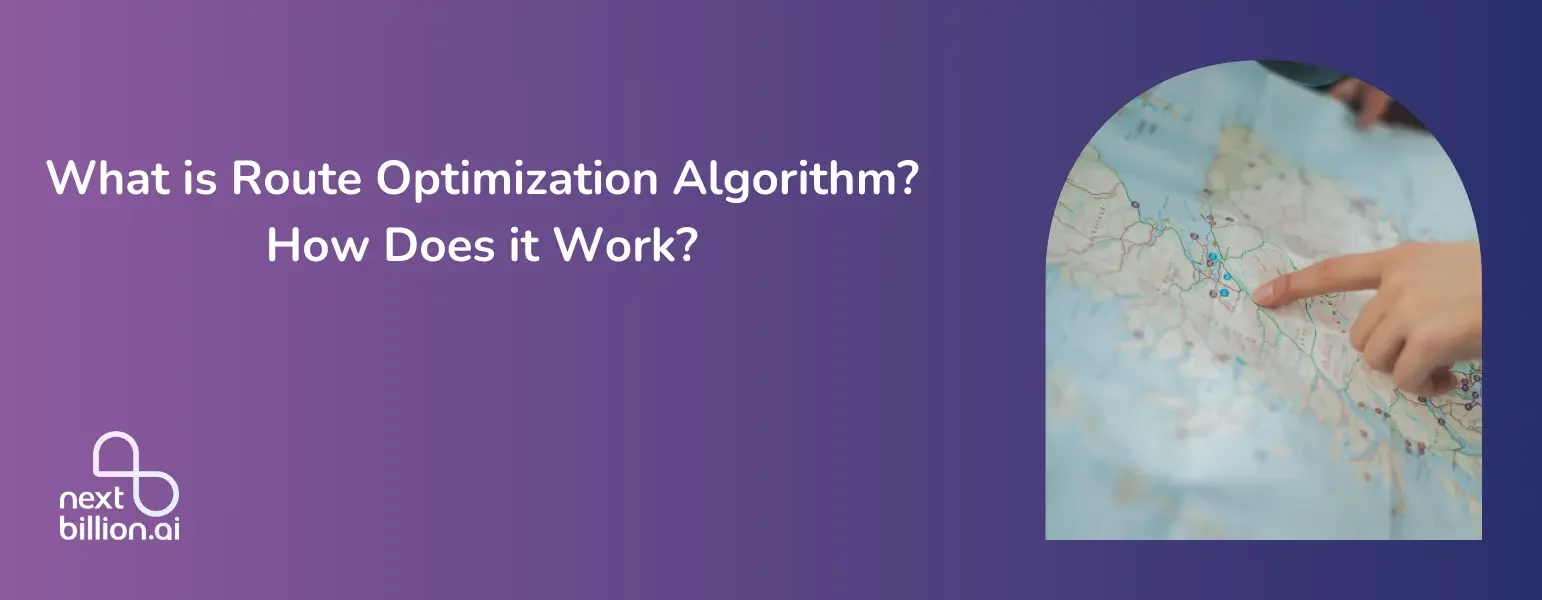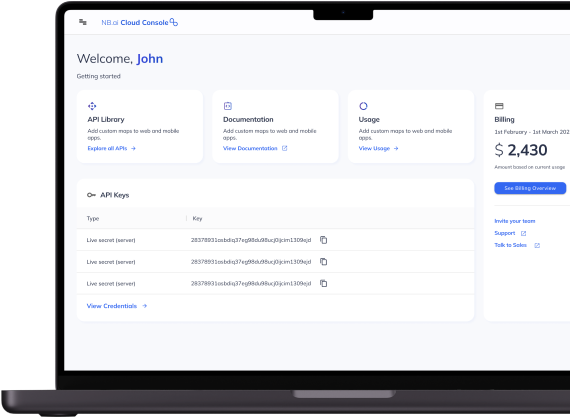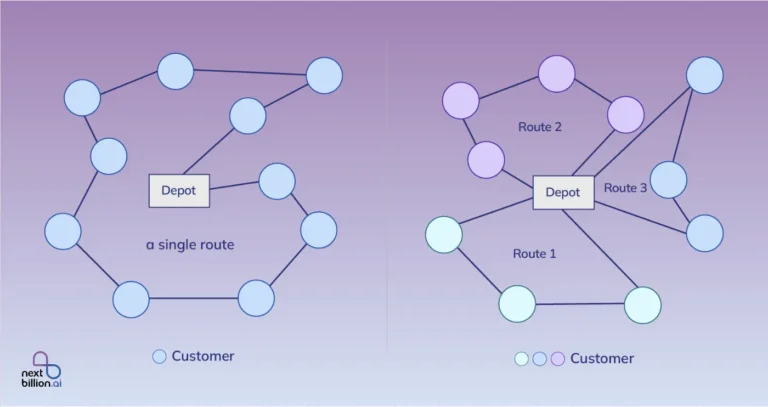
Table of Contents
Route optimization algorithms are revolutionizing logistics and delivery services, making operations faster and more efficient. These advanced algorithms calculate the most efficient routes for multiple deliveries, reducing travel time and costs. By considering variables like traffic, delivery windows, and vehicle capacities, they ensure optimal route planning. In this article, I’m going to look at how route optimization algorithms work to make your delivery processes more efficient and your overall output higher.
What is Route Optimization Algorithm?
Route optimization algorithm is the set of computational techniques determining the most efficient delivery route within logistics operations. It is the supply chain’s critical leg and ensures delivery efficiency and business profitability. It considers many factors, such as traffic, vehicle capacity, weather, etc. It uses advanced and complex algorithms to calculate the optimal route for deliveries and vehicles.
Route optimization algorithms can range from simple to highly complex, each offering different computational time and service quality. It not only manages operational costs but also reduces carbon emissions. It offers adaptability and scalability, which are essential for business growth if done efficiently. It provides flexibility to optimize the routes based on changing circumstances.
How does the Route Optimization Algorithm Work?
The route optimization algorithm helps to discover the shortest possible delivery path. Its working is described in the following steps:
- The first step is to gather necessary data like delivery location, vehicle capacity, traffic congestion, and time windows.
- Next is to identify the problem to be solved, considering objectives and constraints.
- Set up an initial solution based on simple heuristics.
- Now, access the quality of the solution, including defined objectives and constraints. Find the algorithm best suited for the given problem.
- It is necessary to define when to stop the optimization process. Once a particular condition has been achieved or time constraints have been met, the process can be terminated.
- Finally, the optimized route that minimizes the travel distance, maximizes resource utilization and meets the defined constraints is generated.
Different Types of Route Optimization Algorithms
The different types of route optimization algorithms are:
Greedy Algorithm: A greedy algorithm is an approach to solving problems based on the current situation. It is simple and intuitive and requires maximum and minimum optimal results. Moreover, this algorithm is easy to understand and implement.
Dijkstra’s Algorithm: The Dijkstra algorithm is the best option to find the shortest path from a single source node to all other nodes in a graph. Route optimization is used to find the shortest route between a starting point and multiple destinations. It also determines the minimum cost from the source node to all other nodes.
Floyd-Warshall Algorithm: Floyd-Warshall is a dynamic algorithm that calculates the shortest path matrix by considering all the intermediate nodes. Regarding route optimization, this algorithm determines the optimal path between all combinations of initial and destination points.
Bellman-Ford Algorithm: Bellman-Ford is a dynamic algorithm determining the shortest path by iteratively relaxing the edges. This algorithm handles situations involving negative costs or weights and selects the most efficient route based on these constraints.
Heuristics Algorithm: The algorithm uses experience-based techniques to solve the given problem. Its main objective is determining the shortest route between starting and ending points.
Genetic Algorithm: The genetic algorithm is inspired by the natural selection process. In this, the potential routes are generated through crossovers and mutations. It can handle complex routing problems and explore large solutions to find the optimal path. The vehicle routing problem is considered the best example of a genetic algorithm.
Ant Colony Algorithm: As the name suggests, the ant colony algorithm is based on the behavior of ants. It involves observing the behavior of ants when they search for food. Route optimization helps determine the shortest path between the multiple points.
Particle Swarm Optimization: The particle swarm optimization is inspired by the social behavior of fish schools. It involves a particle that adjusts its position by learning from the best solution available within the swarm. Route optimization is used to find near-optimal routes considering costs, distance, and time.
Variable Neighborhood Search: The variable neighborhood search is a metaheuristics algorithm that searches spaces for a better solution. This algorithm searches for better routes by systematically exploring various neighborhoods.
Simulated Annealing: The simulated annealing is a probabilistic metaheuristic algorithm that tries to imitate the annealing process of metallurgy. Route optimization helps find the optimal solution by gradually reducing the system’s temperature.
Benefits of Using Route Optimization Algorithm
Route optimization algorithms increase customer satisfaction by providing more precise and reliable delivery estimations. Moreover, it reduces the costs associated with storage and transportation. Some of its significant advantages are:
Reduce Carbon Footprint: Optimized routes will reduce fuel consumption, contributing to reducing the organization’s carbon footprint. It provides sustainability, which is crucial for company growth.
Resource Optimization: The algorithm optimizes the resource allocation considering various factors such as the number of vehicles, drivers, and carrying capacity. Moreover, it maximizes the efficiency of each resource.
Cost Reduction: It minimizes fuel consumption and operational costs by providing the most efficient delivery route. This ultimately helps in reducing logistics costs and overall operations.
Complex Problem Handling: It can handle simple to complex problems involving multiple constraints, time windows, capacity limitations, and other factors. It solves complex routing problems way more efficiently than the traditional method.
Scalability: It can be applied to various problem sizes, from small-scale to large-scale logistics networks. It can also accommodate the changing needs of organizations.
Time Efficiency: The algorithm reduces travel time, reduces fuel consumption, and increases operational efficiency. It reduces the chances of missed deliveries and improves the customer’s overall delivery experience.
Route optimization algorithms are crucial for the smooth flow of the supply chain and enhance the customer experience. It maintains communication among the different actors involved in the supply chain and increases efficiency, productivity, and the company’s profitability. It improves the efficiency of fleet management and reduces transportation and storage costs. It is considered a powerful tool in the logistics industry.
Explore NextBillion.ai’s Route Optimization API documentation.
Limitations of not using the Route Optimization Algorithm
1. Inaccurate Inputs and Data Reliability
Route optimization algorithms depend on precise and comprehensive data, including customer demand, travel time estimates, road network details, addresses, and vehicle constraints. Without accurate inputs, the algorithms may generate suboptimal or impractical routes. This can lead to inefficiencies, such as missed delivery windows or incorrect delivery addresses, further complicating the logistics process.
2. Reduced Customer Satisfaction
One of the critical consequences of not using route optimization algorithms is the potential decline in customer satisfaction. Customers expect timely deliveries, and failure to meet these expectations can result in dissatisfaction and loss of loyalty. Late or inconsistent deliveries can harm a business’s reputation and drive customers to competitors who offer more reliable services.
3. Limited Accuracy in Route Planning
Route optimization algorithms strive to provide the most efficient solutions possible within a given time frame. However, without these algorithms, businesses may have to rely on manual planning, which often lacks the precision required for optimal route management. Manual planning can lead to routes that are longer than necessary, increasing travel distances and fuel consumption, which in turn raises operational costs.
4. Inefficient Routes and Increased Costs
Without proper route optimization, businesses may face significant inefficiencies in their delivery routes. This inefficiency translates into longer travel distances, higher fuel consumption, and elevated operational expenses. Inefficient routing not only impacts the bottom line but also contributes to increased wear and tear on vehicles, potentially leading to more frequent maintenance needs.
5. Poor Time Management
Effective time management is crucial for meeting delivery schedules and customer expectations. Route optimization algorithms help businesses minimize travel time by generating the most efficient routes. Without these algorithms, businesses may struggle to adhere to delivery time windows, resulting in late deliveries, customer dissatisfaction, and potential penalties for failing to meet service level agreements.
6. Increased Operational Complexity
The absence of route optimization algorithms can make route planning a labor-intensive and time-consuming task. Handling complex problem scenarios involving multiple constraints, such as time windows and vehicle capacities, becomes challenging. This increased operational complexity can hinder overall efficiency, making it difficult for businesses to scale and adapt to changing demands.
the limitations of not using route optimization algorithms are clear, businesses can overcome these challenges by implementing the right solutions.
Real-world Applications of Route Optimization Algorithms
1. Logistics and Delivery Services
Route optimization algorithms are widely used in logistics and delivery services to plan the most efficient routes for multiple deliveries. By minimizing travel time and distance, these algorithms reduce fuel consumption and operational costs while ensuring timely deliveries. Companies like UPS and FedEx rely on route optimization to enhance their delivery performance and customer satisfaction.
2. Public Transportation
Public transportation systems, including buses and trains, utilize route optimization algorithms to design efficient schedules and routes. These algorithms help in reducing waiting times, balancing passenger loads, and improving the overall reliability of public transit services. Cities like London and New York have implemented such algorithms to optimize their transit networks.
3. Ride-Sharing Services
Ride-sharing companies like Uber and Lyft use route optimization algorithms to match passengers with drivers efficiently. These algorithms determine the best routes for drivers, considering factors like traffic conditions and passenger locations. This ensures quick pick-ups and drop-offs, enhancing the user experience and maximizing driver earnings.
4. Field Service Management
In field service management, route optimization algorithms are used to plan the daily routes of technicians and service personnel. These algorithms ensure that technicians can attend to the maximum number of service calls in the shortest amount of time. This application is crucial for companies providing maintenance, repair, and installation services.
Future Trends and Innovations in Route Optimization Algorithms
1. Integration with Real-Time Data
route optimization algorithms will use real-time data sources like traffic updates, weather reports, and road closures. These algorithms will improve accuracy and efficiency by changing routes on the fly. With live data feeds from GPS devices and IoT sensors, decisions about routes will always be based on the most up-to-date information.
2. The Use of AI and Machine Learning
AI-powered algorithms for route optimization will change the way routes are planned. These algorithms will make better decisions because they will learn from past data, customer preferences, and how well they did in the past. With machine learning, these systems will be able to change and get better all the time, making route planning strategies better based on feedback from real people and changing conditions.
3. Self-driving cars and delivery drones
As self-driving cars become more common, route optimization algorithms will need to adapt to work with them, finding the best balance between safety, efficiency, and coordination. As drone delivery services become more popular, they will need special algorithms for flying that can navigate the sky safely and quickly, taking into account rules about airspace and how to avoid moving objects.
4. Routing for multiple modes and between modes
In the future, algorithms will be able to support multi-modal routing, which will make it easy to combine different types of transportation like buses, trains, and bikes for complete door-to-door travel solutions. Intermodal route optimization will find the best routes for routes that use more than one type of transportation. This will make the whole supply chain more efficient and make switching between types of transportation easier.
How AI Is Used in Route Optimization
AI in route optimization is revolutionizing the delivery of goods and services by enhancing efficiency and reducing costs. AI-powered systems analyze vast amounts of data, identifying patterns in profitability, traffic, and consumer demand. This data-driven approach allows for the creation of optimized routes that consider time, distance, and cost-efficiency.
By integrating historical route data with real-time information, AI algorithms maximize vehicle efficiency and generate accurate estimated times of arrival (ETAs) for each shipment. This not only lowers the cost of last-mile delivery but also improves overall operational efficiency, making AI an indispensable tool in modern logistics.
Advantages of AI route optimization
Predictive Fleet Maintenance
AI systems use historical data and real-time usage information to predict future maintenance needs. This proactive approach helps prevent breakdowns, reduces downtime, and extends the lifespan of vehicles, leading to cost savings and improved reliability.
Real-Time Updates for Customers
AI route optimization provides customers with real-time updates based on each driver’s current location. Automated notifications keep customers informed about their delivery status, enhancing transparency and improving overall customer satisfaction.
Accurate Data-Based Predictions
Machine learning models analyze past data to make accurate predictions about the best routes under current conditions. This data-driven approach ensures that routes are optimized for efficiency, taking into account traffic patterns, road closures, and other variables.
Ongoing Learning and Improvement
AI systems continuously learn and improve as they process more data. This ongoing enhancement means that route optimization algorithms become increasingly effective over time, adapting to new patterns and improving performance with each iteration.
Vehicle Tracking
AI route optimization includes precise geographic tracking of each vehicle, giving managers real-time visibility into fleet operations. This tracking capability allows for swift response to challenges and ensures that managers can make informed decisions on the fly.
Disadvantages of AI route optimization
Potentially Inaccurate
Machine learning systems that are powered by AI are still in their early stages of development. They might have trouble making accurate models for places with complicated terrain, strange traffic patterns, or other unique features. This can cause suggestions for less-than-ideal routes that don’t fully take into account local conditions, which makes the optimization less useful.
Variable Limitations
A lot of the machine learning models that are used to optimize routes might not take into account all the important factors that affect how well a route plan works. For instance, the weight of a truck, certain delivery windows, or the time of day can all have a big effect on how efficiently a route works. If these factors aren’t taken into account properly, the routes that are found might not be as useful as planned.
Dependency on Quality Data
For AI models to work well, they need accurate, high-quality data. Incorrect or missing data can make route optimization less effective, which could cause delays and higher operational costs. Updating and maintaining the data set to make sure it is correct can use a lot of resources.
High Implementation Costs
It can be expensive to set up AI-based route optimization systems. Some technology, training, and infrastructure may cost a lot to buy at first, which makes it a big cost for smaller businesses. The costs keep going up because they need to be maintained and updated all the time.
Machine Learning Model for Route Optimization
Machine learning is increasingly crucial for optimizing transportation and logistics processes, particularly through the development of advanced route optimization algorithms. By leveraging inputs such as traffic data, weather forecasts, and historical journey times, these algorithms can chart the most efficient paths for deliveries and other logistics activities.
Recent advances in machine learning, including pattern recognition and predictive techniques, further enhance route optimization. Models like neural networks and random forests can identify road segments that perform well or poorly under specific conditions. While many of these features are not yet fully integrated into real-world applications, they hold significant potential for businesses aiming to achieve optimal route efficiency in the future.
How can the Nextbillion Route optimization algorithm help?
Nextbillion.ai’s Route Optimization API is a robust solution designed to enhance the efficiency of delivery operations for businesses. By addressing the Single and Multi-Vehicle Routing Problems (VRP), this tool helps businesses optimize delivery routes to save time, reduce costs, and maximize overall efficiency. Here’s how the Nextbillion route optimization algorithm can benefit your business:
1. Solving Complex Routing Problems
The Route Optimization Flexible API is equipped to handle complex constraints and variables, such as vehicle capacity, time windows, and availability. Whether managing a single vehicle or an entire fleet, the API finds the most efficient routes to meet your specific business requirements.
2. Efficient Input Data Utilization
The API uses detailed input data, including job locations, vehicle specifications, and shipment details, to determine the optimal routes. This comprehensive approach ensures that all relevant factors are considered, leading to highly efficient route planning.
3. Dispatch-Ready Routes with Multiple Constraints
The API can generate dispatch-ready routes that account for over 50 constraints, combining both hard and soft factors. This means the routes created are highly practical and often require no further editing, streamlining the dispatch process.
4. Logical Task Sequencing
The algorithm supports logical task sequencing, allowing for the inclusion of necessary prerequisites such as tool pickups or refueling stops within the broader routing plan. This ensures that all tasks are completed in a logical and efficient order, reducing downtime and unnecessary travel.
5. Ad Hoc Order Fulfillment
The API excels in handling ad hoc orders or last-minute service requests. It can integrate new tasks into existing routes with minimal disruption, maintaining efficiency and ensuring timely deliveries even with unexpected changes.
6. Customization for Specific Needs
The flexibility of the API allows for customization to meet the unique needs of your business. Whether you need to account for specific delivery windows, vehicle types, or other constraints, the Nextbillion route optimization algorithm can be tailored to optimize your operations effectively.
About Author
Rishabh Singh
Rishabh Singh is a Freelance Technical Writer at NextBillion.ai. He specializes in Programming, Data analytics and technical consulting, turning complex tech into clear and engaging content.








